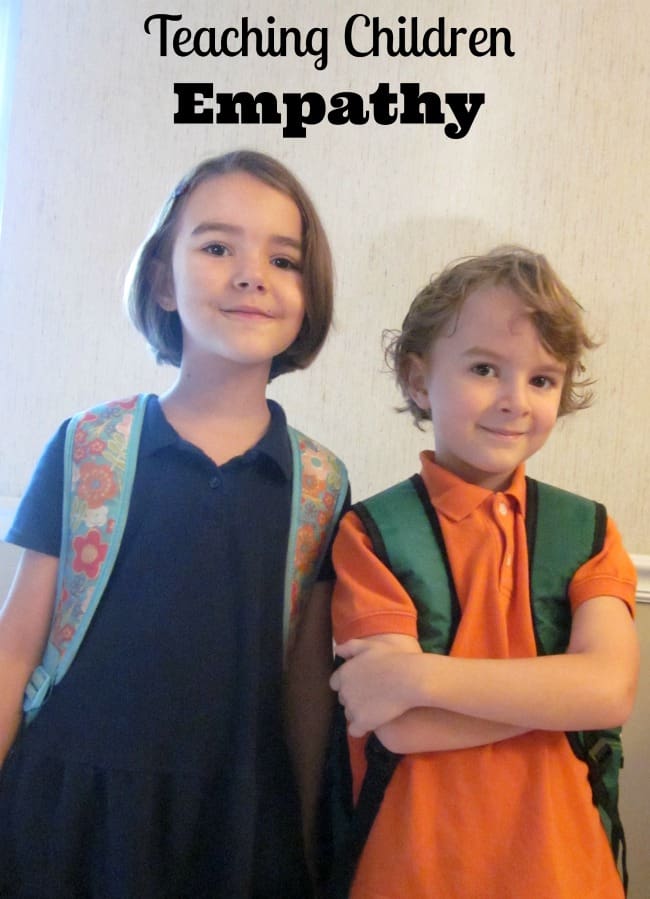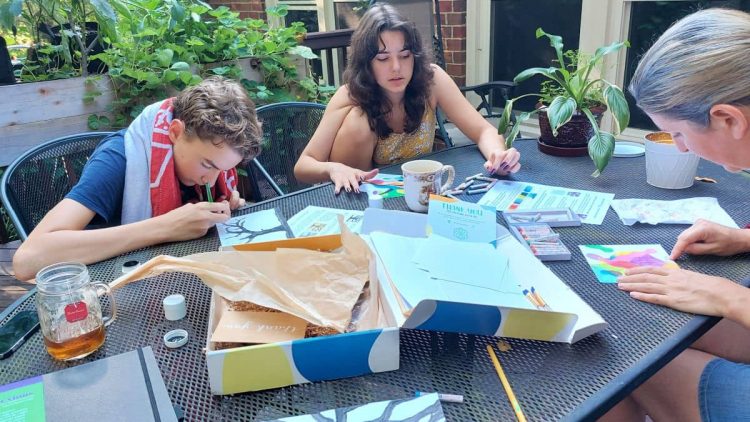
[ad_1]
Teaching empathy to kids is a valuable skill that can help them understand and connect with others. There are several effective strategies to foster empathy in children. As a parent or a children it is our job to model empathy ourselves. Show empathy in your interactions with others. Let your kids see you being kind, listening, and understanding other people’s perspectives. Of course, this includes showing empathy to your child. Acknowledge their feelings and show understanding of their concerns. Beyond this there are many opportunities for how to teach empathy to kids. I will share a whole list of empathy activities for kids to grow their empathy skills as they learn to consider different perspectives.
Empathy is an important skill in everyday situations starting out with sharing as a toddler all the way to business interactions as an adult. Mastering this skill can be tough. Therefore, it is never too early to focus on empathy both inside and outside your home. The meaning of the word empathy is the action of understanding and being sensitive to the feelings of others. It is more than just being nice thought that is part of it. It is the ability to anticipate and understand how someone else may feel when you say or do something.

How To Teach Empathy To Kids
Empathy helps us create more meaningful connections. As Life Hacker puts it, “We are all in our own bubble, with our own unique perspective on the world, and it is crucial for our personal development to understand how other people experience the world…to be truly empathetic, you need actively think about the concerns of others.”
In order to think about other’s feelings, it is important for younger children to learn emotional literacy first. Help children identify and name their emotions. Use books, stories, and real-life situations to discuss different feelings. Teach children to express their feelings with “I feel” statements to communicate their emotions effectively. Then practice acive listening. Show that you value their thoughts and feelings by listening attentively. Repeat back what your child says to show you understand their perspective. For example, say, “I see you’re upset because you can’t play with your friend right now.”
Engage in role-playing activities where children take on different roles and perspectives. Talk about how others might feel in various situations, such as a friend who is sad or a classmate who is bullied. By consistently incorporating these strategies into daily life, you can help your child develop a strong sense of empathy and compassion for others.


Activities About Empathy
At a time when young people are seemingly encouraged by social media and pop culture to be self-absorbed, it is now more important than ever to teach our children how to genuinely respect and care for all people. Teaching children empathy is an important part of producing kids that care about others and that have strong social skills. Today I am happy to feature some excellent activities that teach kids empathy from Eileen Carey, award-winning pop-country singer-songwriter and blogger. Hear her on SoundCloud and check out her blog The Music Mom.
Empathy is a fundamental human quality that plays a crucial role in our social interactions and relationships. Teaching children how to understand and relate to the feelings of others is essential for developing their emotional intelligence. I think you find these three activities that teach kids empathy very useful. Teaching children empathy is not a one time explanation of the meaning of the word empathy. Rather, it is an ongoing process where we model and encourage empathetic behaviors. Here are ways to teach empathy to your children, regardless of their age.
The first 3 tips below are from Eileen Carey.
1. Explore different human emotions with kids.
The first step to successfully empathizing with others is being able to identify one’s own feelings. Kids should be taught to label what they are feeling so they can eventually identify it in others. As your child makes her way through her day, make an effort to point out which emotions you see her feel. For example, you might tell her “I noticed that you’re disappointed because you didn’t have time to play before bedtime.” Likewise, give voice to your emotions: “Momma felt really frustrated just now when our car wouldn’t start.” You can discuss how facial expressions and body language are clues to people’s emotions.
2. Give a voice to those who can’t speak for themselves.
Babies illicit a natural sense of empathy. It is nature’s way of making sure they are properly cared for. Ask your child to try to figure out what a baby is trying to say when he cries: “What does he need? How do you know that?” The same can be done for pets, who often communicate an earful without ever saying a word. This is also the perfect time to discuss the golden rule- do unto others as you would have them do unto you.
3. Model respect for those who seem different.
Children are naturally intrigued, and sometimes even fascinated by, those who seem different. My own kids have awkwardly asked “What is that?” upon seeing someone in a wheelchair. Your first inclination might be to hush your child as quickly as possible, but that is not the best move. Introduce yourself to the person and allow her to meet your child. Many people with disabilities are more than okay with explaining their situation. This is a great opportunity for your child to see that he has more in common with the person than he originally thought.
Here are some more empathy activities for middle school. These five fun and creative activities designed to help kids build empathy in a meaningful and engaging way. From role-playing games to community service projects, these activities will not only foster compassion but also contribute to a more understanding and empathetic society.


4. Art Projects to Encourage Expression of Emotions
Art has the power to transcend words and express emotions in ways that words sometimes cannot. Engaging children in art projects that focus on expressing emotions can be a wonderful way to further deepen their understanding of empathy. Through painting, drawing, or crafting, children can visually represent different emotions they may have experienced or observed in others. Encouraging kids to use colors, shapes, and textures to convey feelings can help them explore the complexity of emotions in a tangible and creative way. These art projects not only serve as a form of self-expression but also foster empathy by allowing children to connect with their own emotions. This allows them to understand how others might feel in similar situations. As children pour their hearts into their creations, they are not only honing their artistic skills but also developing a deeper sense of empathy.
5. Role-Playing Games to Explore Different Perspectives
One way to further explore different perspectives and enhance empathy in children is through engaging role-playing games. By stepping into the shoes of different characters and experiencing situations from various viewpoints, kids can develop a deeper understanding of how others feel and what they may be going through. These games can range from improvisational scenarios to structured simulations, allowing children to practice empathy in a fun and interactive way. As they navigate through different roles and scenarios, kids can gain valuable insights into the complexities of human emotions and relationships. This hands-on approach not only cultivates empathy but also encourages creativity and problem-solving skills.
6. Use Storytelling Activities to Develop Understanding of Others’ Feelings
Storytelling is a powerful tool that can help children put themselves in someone else’s shoes and see the world from a different perspective. By engaging in storytelling activities that focus on characters experiencing various emotions, children can practice recognizing and empathizing with different feelings. Encouraging them to imagine how the characters might feel in different situations can help them develop a greater awareness of others’ emotions and experiences. Through these storytelling activities, children can expand their emotional vocabulary and strengthen their ability to empathize with others.
7. Community Service Projects to Foster Compassion and Empathy
Next, we will explore community service projects to foster compassion and empathy. Engaging in community service activities allows children to actively make a positive impact on the lives of others, fostering a sense of empathy and understanding towards those in need. By participating in projects such as volunteering at a local food bank, organizing a donation drive for a shelter, or even beautifying a community garden, children can learn firsthand the value of helping others and the importance of empathy in creating a more compassionate world.
These experiences can not only deepen their understanding of different perspectives but also instill a sense of responsibility and empathy towards their community. Through community service projects, children can develop a greater sense of empathy by actively engaging with others and making a difference in the lives of those around them. Even random acts of kindness are a great way for elementary students to feel a positive impact of their actions.
8. Group Discussions to Encourage Listening and Empathy
Group Discussions to Encourage Listening and Empathy will further enhance these skills. Gathering children in a group setting to discuss topics related to empathy can be a powerful way to deepen their understanding and foster active listening. Encourage open and respectful dialogue where everyone has the opportunity to share their thoughts and feelings. By actively listening to others and considering different perspectives, children can develop a stronger sense of empathy towards the experiences and emotions of those around them. Through group discussions, children can learn to empathize with others, practice effective communication, and cultivate a greater sense of understanding and compassion within their community.
Conclusion
Still want more activities that teach kids empathy? Try this tip from Michelle Moore, author of A Mother’s Grace. “There are so many ways to open a child’s mind to everyday opportunities of the good around them…Take them out into nature and teach them to respect it, they need to not only respect other human beings but our world and all of the creatures in it. Hike, camp, boat, travel, but don’t just do it, engage your kids into the experience and discuss what they are grateful for and how they can pay it forward.” Here is my affiliate link to the book on Amazon.
I hope these tips help you raise an empathetic and thoughtful child. Remember that kids learn best through encouragement. Sometimes teaching children empathy is as simple as asking a question. If I did something that was not very empathetic as a child, my grandmother would ask me, “Would you like it if I (or they) did that to you?” When I would answer no, she would remind me, “Always do unto others as you would have them do unto you.”
I know that life is not short on challenges but he best way to teach empathy is by modeling it yourself. Our kids are continually watching us, so we will always be the best teachers of what it means to be kind and caring to all people. I hope you find these activities helpful in teaching children empathy. Share you best tips or stories that involve empathy @familyfocusblog!
Related Posts:
Why Is Emotional Intelligence Important?
Teaching Boys To Express Emotions
Examples of Good Deeds
[ad_2]